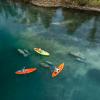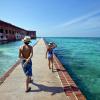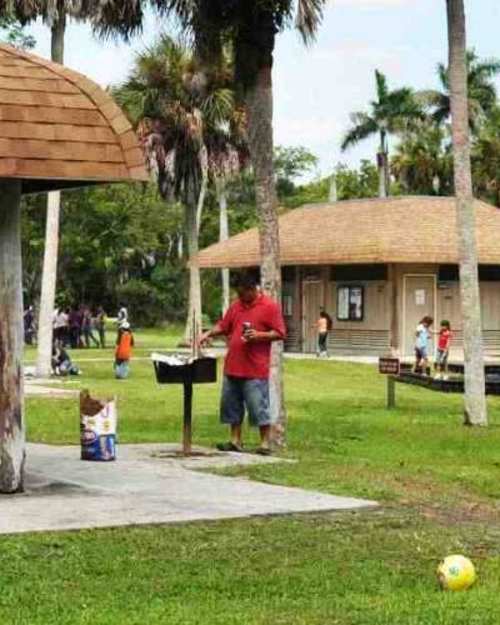A Look at Native American History in Florida
The sites of these Native American tribes in Florida tell a story that no history book can recount.
By Terry Tomalin
The morning breeze has all but died on this warm May morning and I stop along the Memorial Trail on De Soto Point for a quick drink of cold bottled water. I'm the only visitor to this National Park Service Memorial in Bradenton this Wednesday morning. The grounds, part of Florida’s Native American history, are silent, but for that I am glad, for I have come to sit and reflect on a time long gone.
Most weekends, the Manatee River is crowded with watercraft - sail, motor and human-powered - as local residents and tourists alike use this waterway for easy access to the Gulf of America. But today, the water is empty except for a pair of dolphins hunting mullet along the shoreline. So I find a quiet spot to rest and grab a book out of my backpack. Florida's Lost Tribes tells the tale of the state's first inhabitants, and as I sit and read I can't help but wonder if a Tocobaga warrior had found this same place to his liking some 500 years before.
Like the fierce Calusa to the south and the mighty Apalachee to the north, these First Floridians owed their livelihoods to the ocean. They hunted and fished in hand-hewn dugout canoes, traveling up and down the mangrove-lined coast, masters of both land and water. But the life they had enjoyed for thousands of years changed forever on a warm May morning in 1539 when the Spanish conquistador Hernando de Soto sailed into Tampa Bay "conquer, populate and pacify" the land.
With nine ships, several hundred horses, a herd of pigs and a pack of trained "war" dogs, the 700 men of de Soto's expedition were hardened by months at sea and battle-ready. These soldiers of fortune, their armor glistening in the Florida sun, had come for gold. But pride and greed would prove the Spaniards' undoing.
When the conquistadores left the coast, they headed north, lured deeper and deeper into the swamps and forests by tales of fabulous cities full of riches. But this European army was no match for the native inhabitants who used the heat, insects and terrain as effectively as arrows and spears to destroy the Spaniards' will to fight. In the end, only a handful of the original 700 would survive the subsequent four-year, 4,000-mile return to Spain. The rest would succumb to hunger, disease, the elements and an indigenous adversary they had tragically underestimated.
De Soto's army left no monuments or headstones to mark their passing. But the De Soto National Memorial, located in the area where the conquistador is believed to have come ashore, captures this moment in Florida’s Native American history that would ultimately shape the great European nation's role in "La Florida." The Memorial has a visitor center and museum with artifacts dating back to the 16th century.
A Calusa Empire in Southwest Florida
De Soto wasn't the first adventurer to be smitten by Florida's turquoise waters and bright-white beaches. Three decades before, another Spanish explorer, Juan Ponce de León, sighted the body of land that, legend has it, he named "the place of flowers." De León and de Soto were both driven by a hunger for gold. But little did they know that Florida's true riches lay in its sheltered rivers and bays, which allowed the Tocobaga, Calusa, Apalachee and Tequesta to flourish.
It is believed Juan Ponce de León landed near the future site of St. Augustine and later headed south along the east coast, rounded the Dry Tortugas, then entered the Gulf of America and sailed into Charlotte Harbor. There he encountered not primitive savages, but intelligent, sophisticated people with elaborate social systems. They called themselves Calusa, "the fierce people."
Standing atop the 171-acre shell island that today is known as Mound Key Archaeological State Park on Estero Bay, I cannot help but be awed by the breadth and scope of the once-great Calusa empire and this piece of Florida’s Native American history. From their capitol at Calos, which most historians believe was here at Mound Key, these powerfully built, tall warriors - taller than six feet on average when most Europeans of the time barely exceeded five feet - controlled the land and water as far as the eye could see.
Mound Key, once home to several thousand people, had a system of canals and middens, the remnants of the middens are still visible today. Dozens, perhaps hundreds, of double-hulled dugout canoes plied the waters of Estero Bay (just south of where Ponce de León came ashore), as the Calusa traded with other Native American tribes in Florida, the Caribbean and perhaps even Mexico. The 2,000-year-old midden rises 30 feet above the surrounding water, the height achieved inch by inch, year after year, by the discarded shells of the Calusa's seafood feasts.
Charlotte Harbor's Pine Island, a large body of land shielded from the sea by barrier islands, was another point of Native American activity and has yielded some of the most important archaeological discoveries to date. The Randell Research Center at Pineland is affiliated with the Florida Museum of Natural History with an interpretive trail nearly a mile long that leads visitors through the mounds and canals built and engineered by the Calusa, once the most powerful people in all of South Florida. Visit the Charlotte County Historical Center in Port Charlotte to see displays about Florida’s early artifacts.
Today, the Charlotte Harbor/Estero Bay area is a popular destination for anglers, paddlers, bird watchers and boaters. People come back year after year for the beauty of the beaches and solitude of mangrove-lined bays. Legend has it that even Ponce de León put aside his search for the Fountain of Youth and returned here a second time in 1521 with people, supplies and animals intending to form a permanent settlement. Ponce de León was wounded by an arrow during his party's forced retreat by the Calusa. He would never see Florida again, a land he named for its beauty, or find the fabled Fountain of Youth.
Florida's Timucuan Pocahontas
No story from the colonial period has endured the test of time as that of the Timucua maiden who saved a handsome soldier from a cruel death at the hands of her father. Most American schoolchildren have heard of Pocahontas, but few know that the story itself originated in Florida, long before the English settled at Jamestown.
An unnamed shell midden in south St. Petersburg tells the story. In 1528, a one-eyed conquistador named Pánfilo de Narváez led five ships and 400 soldiers to the New World, landing on the shores of Tampa Bay in what is now St. Petersburg. According to legend, a chief named Ucita once ruled all of Tampa Bay. Upon his arrival, de Narváez is said to have seized the chief and demanded gold. When Chief Ucita did not oblige, de Narváez cut off his nose. The conquistador then sent his fleet back to Cuba to fetch more supplies while he traveled north to the land of the Apalachee (Tallahassee) in search of treasure.
When the fleet returned, they found no sign of de Narváez, only a note pinned to a tree on a deserted beach. A young sailor named Juan Ortiz tried to retrieve the message but was captured by the natives. Chief Ucita, still angry about his missing nose, planned to kill Ortiz. Before Ucita could exact his revenge, his daughter interceded and saved the Spaniard's life.
Ortiz's widely publicized tale of survival was supposedly read years later by Jamestown's John Smith, who told a similar tale about another princess named Pocahontas. Today, you can learn more of the conquistadors and the Timucua Indians they encountered at Madira Bickel Mound State Archaeological Site on Terra Ceia Island in Palmetto (the site from which Chief Ucita once ruled). The trip back in time begins with an easy walk down a short trail to the top of the 20-foot-high mound that archaeologists believe dates back 2,000 years and is a significant part of Florida’s Native American history.
A Gathering Place for Native American Tribes in Florida
There are more than a dozen original Native American tribes in Florida - Pensacola, Apalachee, Guale, Timucua, Potano, Ocale, Tocobaga, Mayaimi, Ais, Calusa, Jeaga, Tequesta and Matecumbe - each one with distinctive cultures and customs. But there is one thing that they did have in common: the need for water. Nowhere is this more evident than at the Crystal River Archaeological State Park. Like many of Florida's ancient cultures, the people who thrived on the bounty of this spring-fed river feasted on oysters, crabs and other aquatic life.
Archaeologists believe the Crystal River area was once home to as many as 10,000 Indians, more than double the number of people who live there today. Researchers are not sure of the exact reason - perhaps it was because of the fertile springs nearby - but Crystal River served as a gathering place for political, religious and social purposes from along the west central Gulf coast. Clues included large burial mounds, one of which may contain as many as 1,500 skeletons, a large midden and a 30-foot-high temple mound. The site was also a tourist destination of sorts for Pre-Columbian Indians, with as many as several thousand visitors coming from other areas of the Southeast and Midwest to worship and trade each year.
Seminole Culture on Display
Heralded as America's only "unconquered" people, the Seminoles are descendants of Creek Indians who migrated from the Southeastern U.S. in search of land free of European influences. These proud people fought a series of wars in the early 1800s to ensure their independence and preserve their unique culture. While several museums throughout the country have Seminole exhibits, the Ah-Tah-Thi-Ki Museum on the Big Cypress Reservation houses the nation's largest display of Seminole artifacts. The words "Ah-Tah-Thi-Ki" mean "a place to learn." Located just three miles from the Billie Swamp Safari 17 miles north of Alligator Alley on Snake Road , this 5,000-square-foot museum houses items on loan from the Smithsonian National Museum of the American Indian, including moccasins, leggings, turtle shell rattles, silverwork, beaded sashes and medicine baskets.
Archaeological Finds on Weedon Island
One of the greatest archaeological discoveries in Florida occurred in 1924 in what is now northeast St. Petersburg. Jesse Walter Fewkes of the Smithsonian Institution uncovered several examples of ornate pottery unlike anything seen before. Fewkes named Weeden Island culture after the island where it was found (although the two are spelled differently) and similar artifacts have since been uncovered in other areas of the southeastern United States. Today, the Weedon Island Preserve Cultural and Natural History Center has extensive archaeological programs and one of the best ancient cultural exhibits in the state.
























